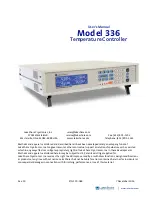
7
6. ID
PLATE AND MARKING DATA
The actuator have
marking and comply with the Standards listed in the Declaration of
Conformity. They also come with a Declaration of Incorporation, due to their classification
by the Machinery Directive as “partly completed machines”. Both declarations are included
in the final pages of this manual.
The plate data is displayed on an adhesive label placed on the outside of the casing, which
must remain intact and visible. The main information it displays includes: manufacturer's
address, product name - model number, technical characteristics, production date and
serial number.
In the event of a complaint, please indicate the serial number (SN) displayed on the label.
An explanation of the symbols used on the label to abbreviate the technical characteristics
is given in the table in the chapter on “
T
ECHNICAL
D
ATA
”.
7. TECHNICAL DATA
ROCK Model
230 V
24 V
Force exerted by thrust and traction
(F
N
)
500 N
Strokes
(S
V
)
100, 200, 300 mm
Power supply voltage
(U
N
)
110-230V~ 50/60Hz
24 V
SELV
Rated absorbed current
(I
N
)
0,21 / 0,14 A
0,63 A
Power absorbed at nominal load
(P
N
)
17 W
15 W
Breaking current
0,80 A (a 24V)
Electrical insulation
Class II
Class III
Average speed
(excluding starting and braking
ramps)
4 mm/s
Stroke end position stop
Electronic with magnetic switch
Ramp duration
(start and stop)
1 s
Service type (D
R
)
2 cycles
5 cycles
Operating temperature
- 20 °C + 70 ºC
Electrical device protection rating
IP66
Parallel power supply
YES
Compatible with: K-LOCK and AUX accessory
NO
YES
Synchronisation
(Syncro³ patent)
NO
YES (max 8)
Power cable length
2 m
Noise level
55 dB-(A)
Dimensions
(mm)
72x34,5x344 / 444 / 594 mm
Device weight
~ 0,890 Kg
~0,870 Kg
Any information reported in this table is not binding and may be susceptible to variations without notice.
8. ELECTRICAL POWER SUPPLY
ROCK actuator is powered with a voltage of:
110-230V~ 50/60Hz:
- “
SOLO
” version - Three-wire power cable with
L
IGHT
B
LUE
: neutral common;
B
LACK
:
open phase;
B
ROWN
: close phase
8
24V SELV – Syncro³ Version - Three-wire power cable with
R
ED
connected to +
(positive) C
LOSE
;
B
LACK
connected to + (positive) O
PEN
;
G
REEN
is the wire for the
communication signal.
ROCK actuator in the 24V version can also be powered by a control unit with emergency
batteries or a safety power supply of at least Class II, with an output voltage of 24V
(min.
20,4V
, max. 30V
), sized according to the number of connected systems.
8.1. Choice of power cable diameter
The voltage drop caused by the flow of current in conductors is a critical aspect for the safety
and proper functioning of the device. It is therefore important to correctly calculate the
diameter of the conductors in relation to the length of the cables.
The following table shows the cable lengths for a gearmotor connected to a rated load.
CABLE DIAMETER
Actuator power supply
24V
110V~
230V~
0.50 mm
2
~20 m
~300 m
~1400 m
0.75 mm
2
~30 m
~450 m
~2100 m
1.00 mm
2
~40 m
~600 m
~2800 m
1.50 mm
2
~60 m
~900 m
~4000 m
2.50 mm
2
~100 m
~1500 m
~6800 m
9. RISK ANALYSIS
To estimate the risk potential of the motorised window and therefore implement the
necessary protective measures, a risk assessment must already be conducted in the
design stage. Risk analysis provides the information necessary for evaluating risk, in order
to make decisions regarding the safety of the windows. Please refer to the Machinery
Directive 2006/42/CE and the applicable parts of standards EN 13241-1, EN 12453 and
EN 12445.
The machine as a whole may create crushing and shearing points on the sliding
door/window and therefore a risk analysis must be made, in compliance with the guidelines
of the sector associations and the Machinery Directive.
The risk analysis indicates making a prior analysis of where to position the actuator, the
route of the power cables and the choice of where to fix the support brackets.
It should be noted that, according to the Machinery Directive, the manufacturer of
the entire system has sole responsible for the application and must also ensure
perfect installation, in accordance with regulations.
10. INSTALLATION INSTRUCTIONS
These guidelines are intended for technical and specialised personnel; therefore, no
comments are made on basic work and safety methods.
All preparation, installation and electrical connection operations must be carried out by a
competent technician; this will ensure the optimal performance and proper functioning of
the system.


























